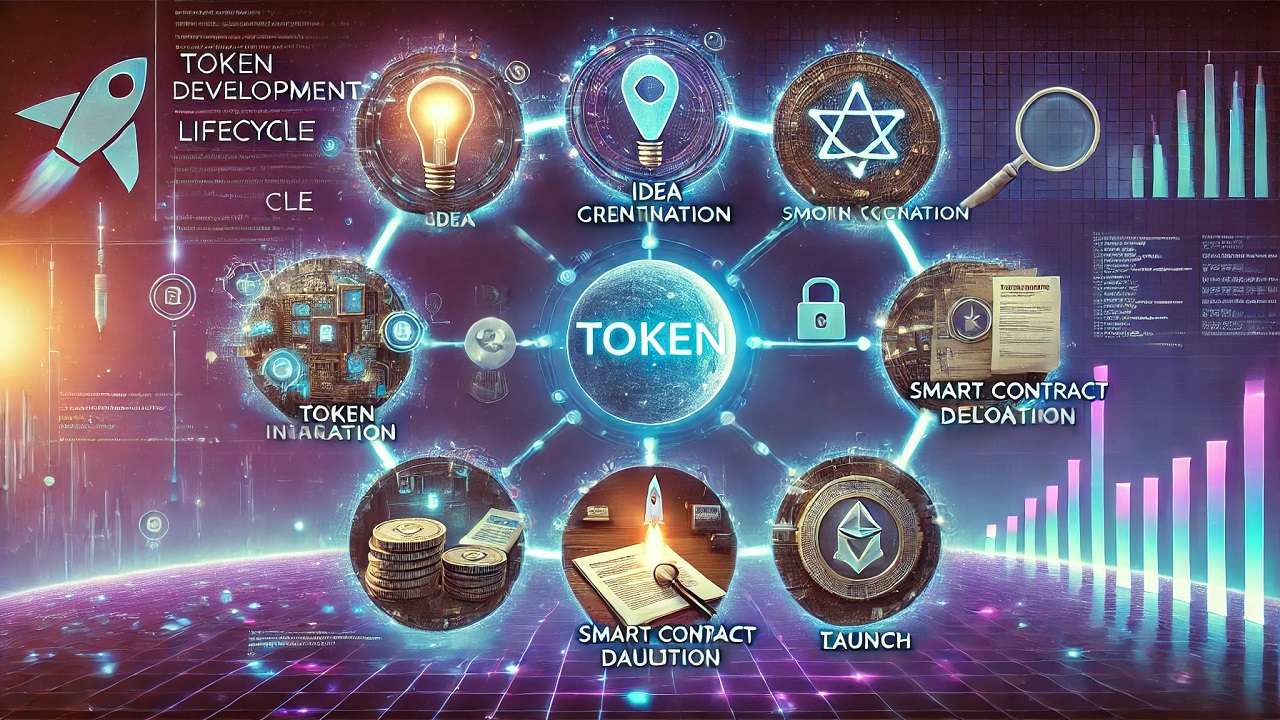Token Development Lifecycle: From Concept to Launch

The crypto industry has evolved rapidly, and token development has become essential for businesses entering the blockchain space. This guide explores the token development lifecycle, from the initial concept to a successful launch. Whether you’re an entrepreneur or a company, understanding these stages will help you create a robust digital asset.
Explore the Token Development Lifecycle from Concept to Successful Launch
1. Conceptualization of the Token
Every successful crypto project starts with a strong concept. This stage involves defining the token’s purpose, features, and real-world application.
Businesses should determine whether the token will serve as a utility, security, governance, or non-fungible asset. A clear use case builds investor trust and sets the stage for development.
For example, a utility token powers a decentralized application, while a governance token allows holders to vote on platform changes. This foundational stage ensures that the token aligns with business goals and market demands.
2. Defining Tokenomics
Tokenomics involves structuring the economic model of the token. This includes deciding the total token supply, distribution methods, and incentives.
Key components of tokenomics:
- Total Supply: Setting a fixed or adjustable maximum supply.
- Token Allocation: Distributing tokens among founders, investors, and the community.
- Inflation/Deflation Mechanism: Managing token value through supply control.
- Utility and Incentives: Defining token functions like staking, voting, and rewards.
A well-designed tokenomics model attracts investors and supports long-term project sustainability.
3. Blockchain Selection
Choosing the right blockchain is crucial. It affects the token’s functionality, scalability, and transaction costs. Popular choices include Ethereum, Binance Smart Chain, and Polygon.
Consider the following when selecting a blockchain:
- Compatibility: Ensure compatibility with decentralized applications (dApps).
- Transaction Fees: Evaluate gas fees for economic feasibility.
- Security: Prioritize blockchain networks with strong security records.
- Community Support: Opt for a blockchain with active developer support.
Selecting the right blockchain helps ensure seamless token development and scalability.
4. Smart Contract Development
Smart contracts are self-executing codes that automate token-related functions. They ensure transparency, security, and efficiency.
A Crypto Token Development Company typically handles smart contract creation. Developers write the contract based on the token’s requirements, ensuring its core functions like transfers, staking, and governance voting.
Essential features to implement:
- Token Transfers: Allow seamless transactions between users.
- Ownership Rules: Define who controls the token supply.
- Automatic Distribution: Enable staking rewards and automated payments.
- Security Protocols: Include safeguards against fraud and hacking attempts.
Smart contract development should be precise and secure to prevent costly errors or breaches.
5. Token Development and Testing
Once the smart contract is ready, developers proceed with token creation. This includes deploying the token on the chosen blockchain and conducting extensive testing.
Important tests include:
- Functionality Tests: Ensure token transfers and staking features work as expected.
- Security Audits: Identify and fix vulnerabilities in the smart contract code.
- Performance Testing: Assess transaction speed and network scalability.
Testing minimizes risks and ensures a smooth user experience. Skipping this step can lead to project failures or reputational damage.
6. Token Wallet Integration
Token wallets store and manage digital assets. Integrating wallet support enhances token usability and accessibility.
Consider supporting major wallets like MetaMask, Trust Wallet, and Ledger. The integration allows token holders to securely store and transfer tokens.
Features to consider in wallet integration:
- Multi-Device Support: Ensure wallets work across devices.
- User-Friendly Interface: Simplify token management for users.
- Private Key Security: Implement secure private key storage.
Proper wallet integration builds user confidence and improves token adoption.
7. Legal and Compliance Considerations
Regulatory compliance is vital for any crypto project. Businesses must adhere to local and international laws to avoid legal challenges.
Key compliance steps:
- Token Classification: Determine if the token is a security, utility, or payment token.
- KYC/AML Requirements: Implement Know Your Customer and Anti-Money Laundering protocols.
- Regulatory Filings: File necessary paperwork with relevant authorities.
Partnering with legal experts ensures smooth regulatory compliance, reducing future legal risks.
8. Token Launch and Distribution
After development and compliance checks, it’s time to launch the token. This stage involves marketing, listing, and distributing tokens to early adopters.
Popular token launch methods include:
- Initial Coin Offering (ICO): Selling tokens to investors before public release.
- Initial Exchange Offering (IEO): Launching tokens through a cryptocurrency exchange.
- Airdrops: Distributing free tokens to generate community interest.
A comprehensive marketing strategy ensures maximum visibility and investor interest. It includes social media campaigns, influencer collaborations, and community engagement.
9. Token Listing on Exchanges
Listing tokens on crypto exchanges boosts liquidity and market visibility. Businesses must choose reputable centralized and decentralized exchanges for broader reach.
The listing process includes:
- Application Submission: Sending detailed project documents to the exchange.
- Token Audit: Undergoing exchange-led audits for security assurance.
- Listing Fee Payment: Covering any associated listing fees.
Once listed, tokens become available for public trading, driving adoption and investment.
10. Post-Launch Maintenance and Updates
The journey doesn’t end with the token launch. Ongoing maintenance ensures long-term success. This includes security updates, feature improvements, and community engagement.
Best practices for post-launch management:
- Security Audits: Conduct regular audits to fix vulnerabilities.
- Community Engagement: Build an active user base through social platforms.
- Partnership Development: Collaborate with other blockchain projects.
- Feature Upgrades: Introduce new features based on user feedback.
Continuous improvement strengthens the token’s market position and ensures sustained growth.
Final Thoughts
The token development lifecycle involves multiple stages, from concept creation to launch and beyond. Businesses must carefully plan and execute each step for a successful project.
Partnering with a Crypto Token Development Company streamlines the process by providing technical expertise and market insights. With the right strategy, businesses can launch a token that stands out in the competitive blockchain ecosystem.